It might be comforting to tell oneself that eugenics—the conviction that one can breed one’s way to better humans by encouraging the fitter ones to have more children and those considered to be less fit to have fewer—was a horrible fad that went out of fashion after the unpleasantness in the mid-20th century. Of course, that’s not true. State sanctioned sterilization of those deemed inferior continues to the modern day.
It’s not surprising that science fiction authors have not always resisted the lure of eugenics as a plot starter. Why not apply to humans the same techniques that transformed the humble wolf into the majestic chihuahua? Here are five stories that engage with the notion in different ways.
“The Marching Morons” by Cyril M. Kornbluth (1951)
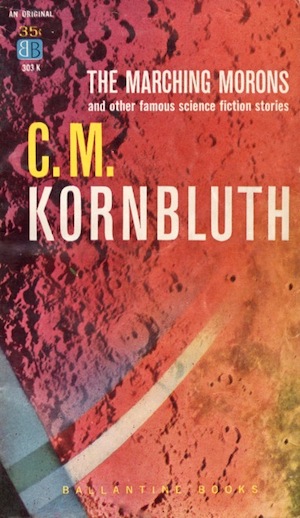
“The Marching Morons” is a cautionary tale told with the gentle humanism one would expect from Kornbluth. In Kornbluth’s world of tomorrow, the lower orders—fertile nincompoops beyond education’s power to improve—see no reason to limit their birthrate, while bright people find no end of reasons to prudently limit theirs. Result: a planet dominated by idiots, kept alive by the unceasing labour of the brilliant minority.
The situation is unsustainable. However, the elite can think of no solution that they would be able and willing to put into action. Their ultimate recourse is to turn to a man of the past unburdened by the concerns that hinder the geniuses. His simple solution? Why, the ultimate destination of many eugenic programs: mass murder on a global scale. However, his reward for cutting the Gordian knot is not all that he might have wished.
The Dosadi Experiment by Frank Herbert (1977)
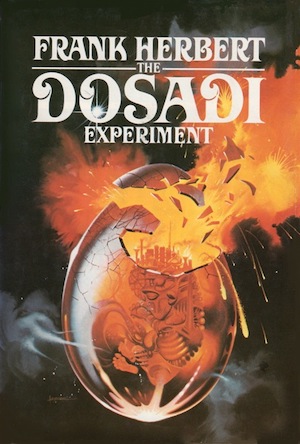
The galaxy-spanning ConSentiency is held together by the Calebans’ “jumpdoors,” through which any two destinations, no matter how far apart, are separated by a mere stride. Bold visionaries saw an intriguing application: divert small numbers of travellers to an isolated, inhospitable world, where a bitter struggle for survival would subject the population to an edifying selective process. What marvels would result?
There is, of course, the minor detail that plagues so many visionary research programs, which is that the project is almost certainly extremely illegal, what with the kidnapping and deaths. The Dosadi Experiment is therefore known only to a few. The last thing the conspirators want is the attention of a Saboteur Extraordinary, those functionaries charged with kneecapping excessively exuberant government programs. Saboteur Extraordinary Jorj X. McKie’s curiosity regarding the Experiment is unwelcome. However, let him visit the Experiment if he pleases. It is, after all, a planet of no return.
The Planet of Adventure by Jack Vance (1968-1970)
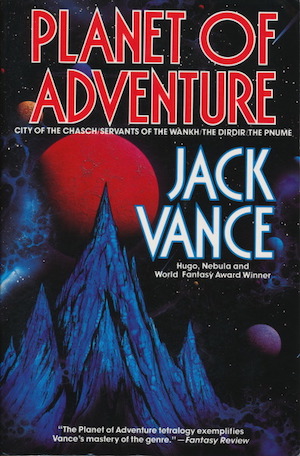
A 1973 omnibus assembled from City of the Chasch (1968), Servants of the Wankh (1969), The Dirdir (1969), and The Pnume (1970), the Planet of Adventure is dominated by four alien races. Thanks to the Dirdir, there are also humans, descendants of neolithic humans collected from the Earth in ages past. Humans could be useful slaves save for one minor detail. Just as each alien race is different from the others, so are humans displeasingly different from all of the aliens. What to do?
The answer is “selective breeding applied over a long time.” If, for example, one desires a good Wankh, but all one has is humans, all one need to encourage—force, really—humans with Wankh-like characteristics to have children and those who lack them to go without children. By the time explorer Adam Reith is marooned on the planet, the four different breeding programs have had their intended effect: each alien species has its associated breed of humanity: Chaschmen, Dirdirmen, Wankhmen, and Pnumekin.
The Gate to Women’s Country by Sheri S. Tepper (1988)
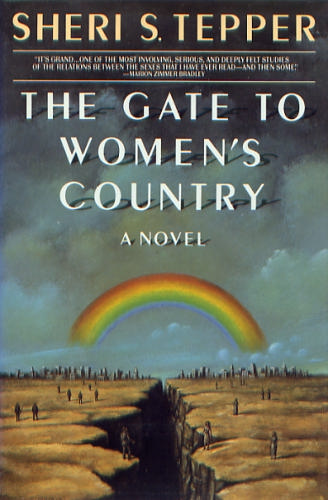
The matriarchal, ecotopian Women’s Country is one way to arrange society. The Holylanders chose a different way. As protagonist Stavia discovers, the Holylander solution places a lot of power in the hands of a few men, with most men being merely brutalized subordinates. All Holyland women are slaves. From the perspective of a woman, the Holylander way is extremely unattractive.
However, the Holylanders are not alone in breeding for traits they prefer. Those who guide the Women’s Country are engaged in a long-term covert eugenics program aimed at ridding the world of such perceived ills as violence and homosexuality. Success depends on behavior being both biologically determined and capable of being “corrected” through science. As it happens, the author certainly seems convinced that it is, which is terribly convenient for her characters.
The Apothecary’s Diary, Volume Three by Natsu Hyuuga
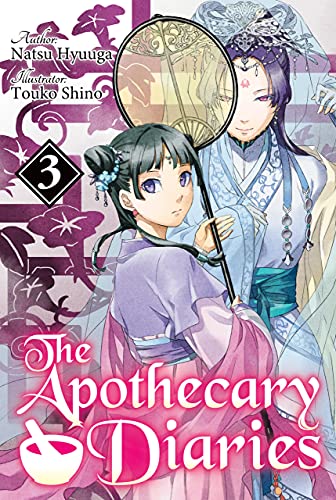
Kidnapped and sold as a servant girl to the rear palace—the harem of the Emperor of Li—Maomao intended to keep a low profile until her contract expired and she could return to her foster-father. Observant, a highly trained apothecary, and incapable of keeping her mouth shut, Maomao instead became an unofficial rear palace detective. Thus far, she has saved lives and revealed killers, at the cost of becoming increasingly entangled in court politics.
In the third novel in the series, she stumbles across a curious example of selective breeding. The Imperial lineage happens to have a minor inheritable trait, one that is deleterious (or at least, mildly annoying) in most circumstances. However, to ensure that this lineage remains on the throne, emperors must pass a test that only people with that specific deficiency can pass. What is in most circumstances an impairment becomes a strength, almost as though the advantageousness or deleteriousness of traits depends on context. See: fitness landscape.
***
There are lots and lots and lots and lots of stories that engage with the topic of eugenics (sometimes in favour—which is always chilling—and sometimes as cautionary tales). Perhaps you have your own notable examples in mind. Feel free to mention them in comments below.
In the words of Wikipedia editor TexasAndroid, prolific book reviewer and perennial Darwin Award nominee James Davis Nicoll is of “questionable notability.” His work has appeared in Publishers Weekly and Romantic Times as well as on his own websites, James Nicoll Reviews and the Aurora finalist Young People Read Old SFF (where he is assisted by editor Karen Lofstrom and web person Adrienne L. Travis). He is a four-time finalist for the Best Fan Writer Hugo Award, is eligible to be nominated again this year, and is surprisingly flammable.










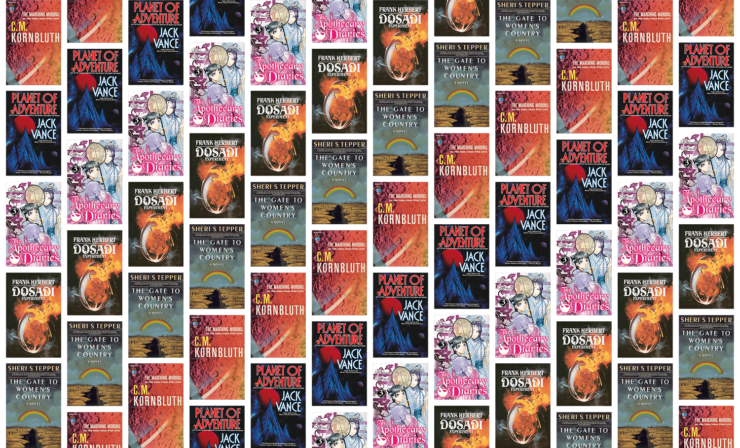
Well, I’ll just get this out of the way and mention Star Trek’s ‘Space Seed’ et seq.
Dune series by Frank Herbert for Kwisatz Haderach’s sake.
There’s Heinlein’s Howard families, who are breeding for extended lifespan via, iirc, financial incentives for desirable matches. Communities with lots of Howards also have homes for “defectives,” presumably caused by inbreeding.
Children of the Lens by Doc Smith, wherein the program by alien superintelligences started well before human history began… (to be fair, at least Doc understands that this would have taken an amazingly long time and lots of effort beyond human capability; not all SF writers have understood the difficulties as well.)
The problem with eugenics is that human genetics are extremely complex and tricky, and there’s good reason to believe that behavior isn’t genetically controlled at all.
There’s a good chance that the only reason the Howard program worked so well is because Lazarus Long kept going back in time to bone his ancestors, thus getting the immortality genes into the lineage early on.
@2, The Bene Gesserit obviously have NO idea how genetics actually work. They seem to have no understanding of the way chromosomes mix and match but have this notion that the traits they want will automatically pass in their entirety to any offspring. Lady Margot’s notion that by having his child she will somehow save Feud Ruatha’s entire genome is painfully naive.
There’s a whole maddening theme of this underlying Larry Niven’s work, from producing “lucky” Teela Brown in Ringworld by allowing only birthright lottery winners to produce offspring and the Puppeteer’s plan to domesticate the Kzinti by manufacturing a war with humanity in which the most aggressive Kzin would kill die over successive generations, producing a more thoughtful cat.
See also Robert Heinlein’s novella “Gulf” (1949). It postulates a group of those with superior intelligence who realize if they could band together and stay genetically-separate, they could develop a new species of humanity that would become a hidden, “benevolent” ruling class. As I recall, one of the characters delivers a speech about how the world is now too complicated and dangerous for “democracy” by the “Common Man,” and so this is necessary for the survival of life on Earth (Heinlein set his much later novel, “Friday,” in this universe as well).
It occurs to me now to wonder whether “The Marching Morons” was written in response to “Gulf.”
8) I found myself wondering a while ago if the reason so many characters in later Known Space have baby rabies is because Niven thinks that’s the end result of the availability of contraception.
@7, I think the Bene Gesserit have control over everything that goes on in their bodies at the molecular level. That’s how I interpret the “neutralize the poison in the spice essence” scene.
I’m not sure how that’s supposed to work, but it implies they can, in fact, pick and choose which sperm cell fertilizes which egg.
Piers Anthony back in the days when he wrote hard sci-fi – Macroscope, which got nominated for a Hugo.
Backstory to novel includes a program to select high intelligence men and women, get them to breed, and then try to raise a huge crop of supergeniuses. Didn’t turn out as planned, program was shut down but in actuality the kids were hiding abilities from the program coordinators and there were several true supergeniuses that came out of the program – one of whom plays a key role in dealing with the titular scary alien technology.
Wasn’t Orson Scott Card’s Ender Wiggin (and siblings) the product of a breeding program? I remember that Peter had most of the traits they wanted but was a bit too psychopathic, so they tried again with Valentine with the assumption that a girl would be less so (worked, but she wasn’t aggressive enough) until finally succeeding with Ender who somehow occupied the Goldilocks zone.
Wasn’t there controlled breeding with the Comyn in the Darkover series? @patrick Morris Miller, were you quoting a filk song on that?
I have a too-vague memory of someone doing the math with humans. It was along the lines of: if 10% of the population has a recessive gene that, if homozygous, is lethal at birth, and assuming random mating, it takes 3,000 years to reduce its incidence to 5%. Except that I don’t remember what the numbers were, except that they were surprisingly high percentages and thousands of years. The point was to show how slow a force selective breeding / natural selection is on beings with as long a generation time as humans, even in a situation where you’d think it would be immediate. Has anyone seen something like this, or done the math?
The eponymous people in The Books of the Raksura by Martha Wells do selective breeding amongst themselves, but in a not creepy way. Family units don’t really exist within their society, and fertilization is entirely voluntary on the female’s part, so people choose partners for the traits that they think will most benefit their court in the next generation.
@14: Yes and yes – though there’s no indication in the lyrics that the protagonist of “The Horse-Tamer’s Daughter” is a Comyn rather than a sport. (I have, but have not read, the story the song’s author spun it into.)
@13 – There was no deliberate breeding program in Ender’s Game, it’s just that the family produced two children who were very close to what the fleet wanted, but each was missing key factors that the other had. Ender was the the “just right” kid who combined all the right things. I don’t know what OSC had set as John Wiggin’s backstory at the time, other than being a Polish Catholic, but years later, in the short story, The Polish Boy, it is established that when the fleet tested John (Jan) for Battle School, he had a lot of what they were looking for, but rather than send him, they made a deal to get his family to America, and waited for his kids. That’s not exactly selective breeding, more like watching the pedigree.
Jack Vance’s The Dragonmasters has as a central element, parallel breeding programs carried out by two races on each other.
@11, even if true it won’t give the subject’s entire genome. Or even the traits you want.
@15 – that’s something that’s taught in population genetics courses – can’t give you the numbers offhand, but the way you describe it is fundamentally correct. Natural selection, particularly in large populations, can take a long time to eliminate a lethal recessive.
Another problem with selection against a lethal allele, even if it’s dominant, is the generation of new instances of it in a population, by mutation. That’s going to depend upon how large a mutation is required, but single-base deletions or insertions, or substitutions, probably happen a lot – each of us apparently carry some 200 of these, each of which occurred during the formation of the gametes that gave rise to us.
@5:
there’s good reason to believe that behavior isn’t genetically controlled at all.
There is equally, if not better, reason to believe that behavior is genetically conditioned. I highly recommend Robert Sapolsky’s book Behave, which starts at the molecular level and works up to the social, cultural, and historical levels to provide a (I hate this word) holistic view of where our behavior comes from. Genes plus nutrition plus regulating hormones plus economic environment plus fasmily dynamics plus social environment plus cultural norms and factors plus legal and political factors plus historical factors … and I’m sure I’m leaving something out … perhaps do not “control” or “determine” behavior: but I am willing to bet that a model that took all these factors into account would prove to have a high abilityi to predict human behavior on an individual level.
Of course the ability to gather all those factors about an individual and keep them updated, together with the massive computational capability required to calculate them all in such a hypothetical model, tends to make that point somewhat moot, except to say that if you leave genetically-conditioned factors out of your explanation of human behvior you are missing something every bit as important as if you left out culturally-determined factors.
No, I am not a eugenics nut. I am convinced by scientific evidence (from far more sources than one book, however well-researched and -documented) that genetics plays a nontrivial part in my and your behavior.
None of which makes us deterministic robots. The complexity of all these things and the complexity of melding them produces a situation where (as famously in chaos theory) a small change in initial conditions can have a huge change in outcomes. The question is not whether we have “free will”; it is whether we even know what it would mean to have it.
We seem to be getting into a debate about the science of eugenics and leaving the original discussion behind, so before we get too far into the weeds, let’s please get back to talking about fiction…
Then there’s “In the Barn” by Piers Anthony that appeared in Ellison’s Again Dangerous Visions. It was… problematic at best. Using humans as beasts of burden and food sources… eeeehhh….
James Alan Garner’s “Three Hearings on the Existence of Snakes in the Human Bloodstream” features accidental eugenics, as the discovery of the microscope in an alternate early Modern Europe leads to a new kind of prejudice and possibly enough self-segregation to lead to speciation. The story was in a very close three-way race for the 1998 Hugo but didn’t quite make it https://www.tor.com/2011/08/28/hugo-nominees-1998/comment-page-1/#comment-207265
The mention of “The Planet of Adventure” reminds me that years ago, I was looking through a British encyclopedia of Science Fiction.
The author, with stereotypical British understatement, mentioned “the unfortunately titled “the Servants of the Wankh.”
I imagined asking for that book in a British bookstore and had a good laugh.
Alliance/Union
Half Past Human. T. J. Bass, I think. Not sure if the nebbishes were the desired endgame, but they certainly were left with a seriously winnowed gene pool.
Captive Universe by Harry Harrison. Two groups of colonists are each genetically conditioned to be stupid and docile, and kept separate for generations. When they finally cross someday, the kids will be geniuses.
Eutopia
Volk.
David Nickle.
Gordon Dickson’s Childe Cycle (aka the Dorsai series) has as one of its themes humanity’s evolving into several Splinter Cultures such as the Dorsai, Friendlies, and Exotics, and then the reintegration of those strands.
I think there might be a few of these in the Dangerous Visions books. I can only recall the one where you can have all the kids you want up to about age 3.
One word: Cetaganda.
#3. Also note that if the Howards hadn’t kept the “defectives” alive, they wouldn’t have had a telepath to spread the word that the Howards had to escape.
I’ll cite Earthblood by Keith Laumer and Rosel George Brown as easily the most genetically bigoted sf I’ve read, though I’m not sure there’s deliberate eugenics in it. The main character has pure Earth genetics and is considerably superior to the other characters.
The Iron Dream by Spinrad has eugenics.
Skylark of Space by Doc Smith has an alien humanoid species which has practiced eugenics for a long time. On the one hand, they’re supposed to be superior, on the other, if I recall correctly, they’d have lost to their enemies (I can’t remember if the enemies also used eugenics) without some extremely unlikely help from earth.
Does Aragorn’s lineage count as eugenics?
In Total Eclipse by John Brunner an alien civilization engineered itself into higher intelligence. Sadly for them, this was not the same as survivability in other aspects…
Uplift.
David Brin.
Rediscovery of Man
Underpeople
@29. Ah, that’s quite right! I read Cyteen last year, and while it was more focused on cloning, it was definitely a eugenics cloning.
Altho not eugenics exactly but certainly selective breeding, George Turner has several books, including Brain Child and The Destiny Makers.
I don’t know that it was handled very well or accurately, but the Divergent series had definite eugenics elements with people divided into factions based on dominant traits that they self-identify, with the scientists outside looking for “genetically pure” people who incorporated all the factions’ traits. It’s bad at the personality science, come to think of it, as well as the genetic science. But it sold well.
Octavia Butler’s Wild Seed has the clearest exposition of it, but it runs through all the Patternist books. Psychic immortal bodychanger Doro selectively breeds humans that “taste good” when he psychically eats their mind and takes over their body. Humans that taste good have psychic powers….
Burton & Swinburne series.
Mark Hodder
@8: IIRC, neither of those was the result of deliberate breeding. Certainly humans all had one birthright; Teelas were the ones with generations of winners from the lottery that distributed a surplus of permits (e.g., from people who died before reproducing), and (at least in Ringworld) a Puppeteer says they’d watched the Kzinti lose 2/3 of their males in each of several generations — no need to interfere, just get popcorn.
@23: the story is problematic only if you don’t realize that Anthony was denouncing the idea — and by implication (ISTR) the idea of breeding even non-sentient animals for food. (This comes from my recollection of the accompanying material in the original publication — that was a long time ago and I don’t know whether the story was republished without the comment.) The fact that newborns have to be ~disabled points to this reading — but it’s not especially clearly presented as repulsive.
@34: that sounds like Lee Hoffman’s “Soundless Evening”, in which children were killed for population control on reaching age X. There was no selection presented; the story had small children being considered low-resource toys — the single scene didn’t get into how the population wasn’t crashing.
There were also early counters to the idea of eugenics; in Heinlein’s first published non-YA novel, Beyond This Horizon (1948), people can filter traits they don’t want to pass on via test-tube breeding, but the one attempt at breeding a superman (or at least a super-soldier) failed some time ago, and an insurrection intended to install eugenics is mocked before it’s put down by the heroes. wrt “Gulf” and Friday, ISTR that the ubermensch program of the former was dissed as a failure by the latter. OTOH, there’s Sturgeon’s “Microcosmic God”, who took particular pleasure in ~”cutting a fanatical eugenicist into conversational ribbons” — but then created a new species on which to do forced evolution (no separating into “fit” and “unfit”, just application of stress after stress).
@48: IIRC both things were deliberate on the part of Puppeteers. They bribed humans to install the birthright lotteries, and lured Outsiders into human space to give us hyperdrives to fight the Kzin better.
Beyond This Horizon is very pro-eugenics, and tries to show how to do it humanely. Most people are the product of advised breeding, and the first half of the book is officials desperately trying to convince the star-line protagonist to pass on his genes. Some people are kept as a ‘wild-type’ population for diversity and backups, “control naturals”, and subsidized for their disadvantage; a few are experiments, and subsidized for their risks.
Brave New World, IIRC, mostly isn’t actually eugenics; the various castes are from manipulation of fetal development.
Bujold has various forms of eugenics. Barrayar traditionally culls “mutant” infants due to a low-tech and hardscrabble history possibly involving actual harmful mutations, but also picking up non-mutation birth defects. Galactic culture has “gene-cleaning” as a standard option for parents. Cetaganda has the heavily engineered haut and the part-engineered part “Social Darwinist” ghem, and unseen “servitor classes”. Betans somehow expect a lifespan of 120+ through good genes. In another universe, Lakewalkers are concerned with avoiding marriage with unmagical ‘farmers’, and are themselves clearly the result of magical engineering. The Five Gods universe seems free of anything like human eugenics.
Hodgell’s Kencyrath are pretty concerned with bloodlines, not without evidence, though the heredity involved is likely magical as much as biological.
Really, any setting with significant magical power that has a hereditary component will have trouble avoiding eugenic-like thought.
Tolkien is a mixed bag. Tolkien writes somewhere about descent from Luthien (herself a half-angelic elf) ‘ennobling’ humanity, or at least that royal line of it; OTOH the description of the Kin-Strife rejects the idea of racial purity. And AIUI, conservative Catholics were among the few groups in the early 1900s one could count on to be against eugenics. (AIUI some African-Americans supported it too, just with different selection criteria than white racists.)
Charles Stross’ Merchant Prince series features a clan of families keeping careful track of genetics in order to preserve ad promote a helpful mutation that is recessive.
@25 Only surpassed by this articles “If one desires a good Wanke”…
I vaguely remember that Jack Vance also wrote “the Dragon Masters” about parallel breeding programs of humans and alien “Dragons” by each species, using captives from a previous encounter. I remember reading it as a kid, but still having pretty strong doubts that genetics worked that way.
‘This perfect day’, by Ira Levin. A supercomputer rules the world and has created world peace through control and equality, matching people over generations to make everyone look &act pretty much the same (helped by mandatory drugs & hormone treatments). All humans are light brown, short and slender; even gender differences are minimized. Any physical variation, for example freckles or green eyes makes you a controversial person. Very interesting concept (execution somewhat disappointing).
@36/@50
Part of this depends on whether you consider long term, persistent endogamy, as practiced among the Numenoreans/Dunedain and among some royalty* to be a primitive expression of eugenics.
*(In the latter case, when practiced to extremes, we know it had disastrous consequences, such as the Spanish Habsburgs and some Egyptian dynasties.)
Tolkien, it seems, was indeed a mixed bag. I’m guessing he viewed the concepts of modern eugenics with horror (I’d have to do some research of his published correspondence to find out) but he did use older concepts of “good “and “bad” blood to some extent.
Did Tolkien mean the situation with the Kinstrife to be, In part, a reaction to what was happening in Europe at the time? Was it endogamy/inbreeding to the point of decadence/evil vs. the royal line being strengthened (or compromised?) by an infusion of outside but related blood? After all, the Rhovanionish blood that came into the Gondorian royal line was from a people who were explicitly stated to be descendants of the same folk that gave rise to the Gondorians’ own ancestors, the Edain.
Those same people from Rhovanion were also the same people that became the Rohirrim, or closely related to them. And the enemies of the riders of Rohan, the Dunlendings, IIRC are descendants of, or related to, those tribes of Men that migrated into Beleriand with the Edain in the First Age but deserted to Morgoth’s service.
> a people who were explicitly stated to be descendants of the same folk that gave rise to the Gondorians’ own ancestors, the Edain.
Tolkien also wrote somewhere, maybe in HoME, that that was mostly a myth made up by Gondor to make themselves feel better about their allies, particularly about giving up half their land to the Rohirrim.
Even if the Eorlingas were a direct branch of the House of Hador, from the ancient migration westward, they would have been separated from the Beleriandic Edain for 5500 years…
It was important for some reason that Aragorn descends from Isildur in firstborn male-line descent, but it’s also said (Appendix A) that the decline in Dunedain lifespan in Gondor came from a “slow withdrawal of grace”, not blood-mixing. Insofar as there is heredity, a lot of it seems to be actual inheritance of grace or magic, not proto-genetics.
OTOH you’ve got the story of Tal-Elmar, very clearly taking after his mother’s kin, and allegedly something in HoME rationalizing Samwise as being part Fallohide.
But Tolkien changed his mind a lot about some things. (Like, half a dozen orc origins? None of which are entirely satisfactory?)
Tolkien’s Kinstrife was indeed a revolt of the pure-blood fanatics against a king of mixed blood, who afterwards proved to be as robust and long lived as his predecessors, while the defeated proto-Nazi rebels retreated to Umbar to lick their wounds, eventually becoming leaders and rulers of Gondor’s nemesis there.
Yes, Aragorn is descended in firstborn male line descent from Isildur, a fact which beggars belief given that it lasts for a span of what, about 3,000 years?
It’s interesting, though, that he has the line of Elros from which it derives fail in the main male line, coming to an end with the fall of Numenor. His descendants, the lords of Andunie and subsequently, the kings of Arnor and Gondor and the chieftains of the Dunedain, continue from a daughter and the eldest child, Silmarien, of the 4th king, Tar-Elendil. (It’s also interesting that she was bequeathed a whole bunch of the house’s heirlooms, such as the ring of Barahir, and that they did not stay with the royal line. But then they’d have sunk with Numenor.)